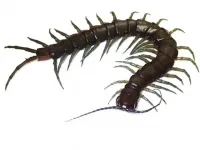New amphibious centipede species discovered in Okinawa and Taiwan
Godly proportions for rare jade Scolopendra named after local gods, one of the largest arthropods in Japan
2021-04-17
(Press-News.org) Tokyo, Japan - Researchers from Tokyo Metropolitan University and Hosei University have discovered a new species of large, tropical centipede of genus Scolopendra in Okinawa and Taiwan. It is only the third amphibious centipede identified in the world, and is the largest in the region, 20 cm long and nearly 2 cm thick. It is also the first new centipede to be identified in Japan in 143 years, testament to the incredible biodiversity of the Ryukyu Archipelago.
Scolopendra is a genus of large, tropical centipede, one of the original genera named by the father of modern taxonomy himself, Carl Linnaeus. They are strong predators in any soil ecosystems they inhabit, with around 100 different species found in tropical regions around the world. Of these, only five have been identified in Japan and Taiwan.
Scientists were excited when news came in of an unknown centipede species sighted around the Ryukyu Archipelago, reportedly attacking giant freshwater prawns. A team led by Sho Tsukamoto, his supervisor Associate Professor Katsuyuki Eguchi of Tokyo Metropolitan University, and Professor Satoshi Shimano of Hosei University set out to look for and identify this mystery creature.
It turned out that they had discovered an entirely new species. Genetic analysis confirmed that it was distinct from any of the other Scolopendra inhabiting the region. Approximately 20 cm in length and 2 cm in width, it is the largest centipede species to be found in Japan and Taiwan. Sporting a beautiful jade-colored shell, it has been named Scolopendra alcyona Tsukamoto & Shimano after the Greek mythological figure Alcyone, who was transformed into a kingfisher by Zeus. Its new Japanese name, ryujin-ômukade, also has a mythological origin, in homage to the region where it was found. Local myths have it that a dragon god, or ryujin, was in agony because a centipede had entered his ear. On seeing a chicken quickly devour a centipede, it was said that the god came to fear both centipedes and chickens. In the days of the kingdom of Ryukyu, people painted chickens on their boats and hoisted a centipede flag to strike fear into the dragon gods and cross the sea safely.
Notably, the scientists found that the centipedes preferred streamside environments, and exhibited amphibious characteristics, making it only the third amphibious Scolopendra in the world. This is the first discovery of a new centipede in Japan in 143 years; the fact that such a large invertebrate could go undiscovered until now is a reflection of the unexplored biodiversity of the Ryukyu Archipelago, and a strong case for its preservation. The species is most likely endangered, and currently inhabits forest streams where people do not go. The team hopes to continue to monitor and study them from a safe distance, to preserve their habitat.
INFORMATION:
This work was supported by the Asahi Glass Foundation (Leader: Katsuyuki Eguchi; FY2017-FY2020; Leader: Satoshi Shimano, FY2020-FY2023), a JSPS KAKENHI Grant-in-Aid for Scientific Research (18K06392), the Tokyo Metropolitan University Fund for TMU Strategic Research (Leader: Prof. Noriaki Murakami; FY2020-FY2022) and the Nippon Life Insurance Foundation.
[Attachments] See images for this press release:

ELSE PRESS RELEASES FROM THIS DATE:
2021-04-16
Research shows that a new telescope could detect a potential signature of life on other planets in as little as 60 hours.
"What really surprised me about the results is that we may realistically find signs of life on other planets in the next 5 to 10 years," said Caprice Phillips, a graduate student at The Ohio State University, who will share preliminary findings at a END ...
2021-04-16
From engineered pandemics to city-toppling cyber attacks to nuclear annihilation, life on Earth could radically change, and soon. Scientists will forecast the fate of the planet at a END ...
2021-04-16
Tarantulas are among the most notorious spiders, due in part to their size, vibrant colors and prevalence throughout the world. But one thing most people don't know is that tarantulas are homebodies. Females and their young rarely leave their burrows and only mature males will wander to seek out a mate. How then did such a sedentary spider come to inhabit six out of seven continents?
An international team of researchers, including Carnegie Mellon University's Saoirse Foley, set out on an ancestry.com-like investigation to find the answer to this question. They looked to the transcriptomes, ...
2021-04-16
Faced with the tragic loss of the Arecibo observatory in Puerto Rico and the often prohibitive cost of satellite missions, astronomers are searching for savvy alternatives to continue answering fundamental questions in physics.
At a END ...
2021-04-16
JUPITER, FL--Making memories involves more than seeing friends or taking photos. The brain constantly adapts to new information and stores memories by building connections among neurons, called synapses. How neurons do this--reaching out arm-like dendrites to communicate with other neurons--requires a ballet of genes, signaling molecules, cellular scaffolding and protein-building machinery.
A new study from scientists at Scripps Research and the Max Planck Florida Institute for Neuroscience finds a central role for one signaling molecule, a long, noncoding RNA that the scientists named ADEPTR.
Using a variety of technologies, including confocal and two-photon microscopy, they track ADEPTR's moves, watching as it forms, travels, amasses at the ...
2021-04-16
AMES, Iowa - A lot is riding on the continued advancement of plant sciences.
Take the food supply, for starters. Climate change and population growth will continue to pose challenges in the future, and crop production will require innovation and progress by plant scientists in order to keep pace. It isn't an overstatement to say that populations around the world will go hungry if plant science stagnates, said Gustavo MacIntosh, a professor in the Roy J. Carver Department of Biochemistry, Biophysics and Molecular Biology at Iowa State University.
"At the end of the day, either you eat plants or you eat food that ate plants," MacIntosh said. "Plants are the basis for the food we have."
MacIntosh predicts ...
2021-04-16
When the Electron Ion Collider received the go-ahead in January 2020, it became the only new major accelerator in the works anywhere in the world.
"All the stars aligned," said Elke-Caroline Aschenauer, Brookhaven National Laboratory Staff Scientist and a leader in developing the EIC plans. "We have the technology to build this unique particle accelerator and detector to do the measurements that, together with the underlying theory, can for the first time provide answers to longstanding fundamental questions in nuclear physics."
The EIC isn't the only Brookhaven project poised to reshape nuclear and particle physics. Forthcoming data from the Relativistic Heavy Ion Collider could finally detect the elusive chiral magnetic effect. Meanwhile, planned accelerators could run on sustainable ...
2021-04-16
LOS ALAMOS, N.M., April 16, 2021 -- Large-scale supercomputer simulations at the atomic level show that the dominant G form variant of the COVID-19-causing virus is more infectious partly because of its greater ability to readily bind to its target host receptor in the body, compared to other variants. These research results from a Los Alamos National Laboratory-led team illuminate the mechanism of both infection by the G form and antibody resistance against it, which could help in future vaccine development.
"We found that the interactions among the basic building blocks of the Spike protein become ...
2021-04-16
Researchers within the Biomedicine Discovery Institute at Monash University have made a breakthrough in understanding the role played by high-risk immune genes associated with the development of rheumatoid arthritis (RA).
The findings, published in Science Immunology, were the result of a seven-year collaboration led by Monash University, involving Janssen Research and Development, USA and the Karolinska Institute, Sweden.
Certain immune system genes, called Human Leukocyte antigen (HLA)-DR4, cause an increased susceptibility to RA. In this study, using mice genetically ...
2021-04-16
The social science literature has long viewed homophily and network-based job recruitment as crucial drivers of segregation. Researchers at Linköping University and ESADE, Ramon Llull University now show that this view must be revised. In their Science Advances article, they call attention to a previously unidentified factor, the Trojan-horse mechanism, which shows that network-based recruitment can reduce rather than increase segregation levels.
The segregation of labor markets along ethnic and gender lines is an important source of socio-economic inequalities. Therefore, the understanding the mechanisms that drive segregation ...
LAST 30 PRESS RELEASES:
[Press-News.org] New amphibious centipede species discovered in Okinawa and Taiwan
Godly proportions for rare jade Scolopendra named after local gods, one of the largest arthropods in Japan









